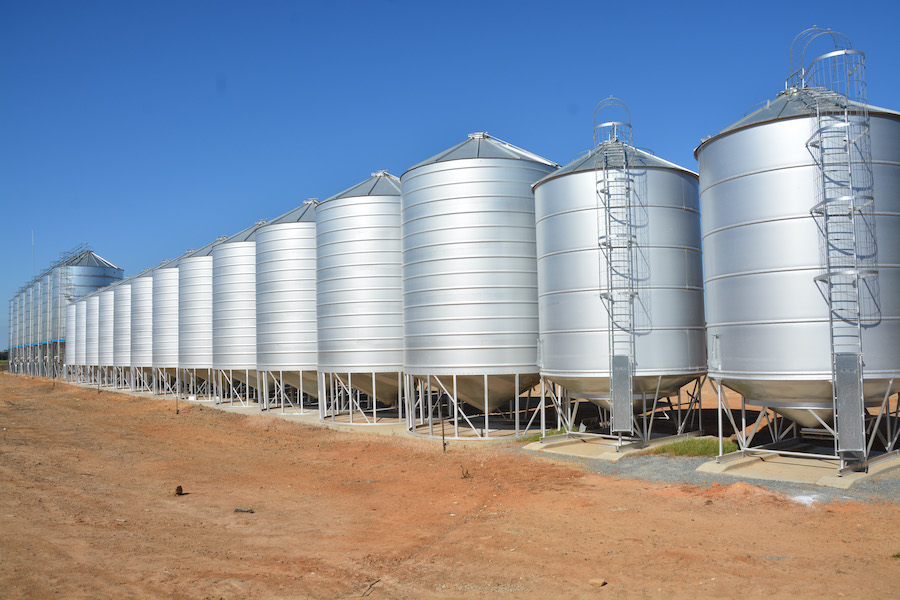Bullish crop production forecasts for the 2021 season gave many growers the confidence to look ahead at harvest logistics and grain storage capacity.
While Australian Bureau of Agricultural and Resource Economics and Sciences predictions of a 46.8-million-tonne crop – 13 per cent above the 10-year average – are only a forecast until grain is in silos, storage specialists encouraged growers to ensure facilities were prepared.
GRDC grain storage extension project coordinator Chris Warrick says growers are increasingly choosing on-farm storage and are focusing on improved capacity, understanding what is needed to store grain for longer periods and building up knowledge of fumigant and chemical use. “Managing on-farm grain storage is now an enterprise in itself, requiring planning and preparation to manage successfully,” he says.
“The GRDC grain storage team regularly receive calls from growers either looking for guidance on setting up storage, including pest prevention, or looking for help after they have discovered a pest or grain quality problem.”

GRDC grain storage expert Chris Warrick says growers are increasingly choosing on-farm storage. Photo: Alistair Lawson
To reduce the risk of issues during and post-harvest, Mr Warrick recommends making time to assess grain storage systems and undertake maintenance and make improvements. “Preventing issues is always better than dealing with them,” he says.
“Some people often forget about maintenance of grain storage. They think about maintaining machinery, but they forget that – like most things on the farm – grain storage also needs maintenance. That means checking the seals, whether silos are gas-tight, fixing damage around the silo (for example, to hatches) and repairing any rust on silos.
“It’s a lot easier to make repairs and fix any issue during the off-season, when you have a bit of time and the storage is empty, so you can find leaks.”
He advises six steps to prepare for harvest:
- Aeration cooling is under-utilised in many regions, possibly due to a lack of understanding. Aeration cooling can be ordered for new silos or retrofitted to existing silos and is an effective way of preventing insects and mould, maintaining superior grain quality and providing storage to hold high-moisture grain safely until it can be blended or dried.
- When choosing aeration fans, aim for two to four litres of air per second per tonne of grain storage capacity. One fan cannot adequately be ducted to multiple silos or effectively moved between silos. The most efficient solution is to have dedicated fan(s) installed directly on the bottom of each silo.
- Existing aeration can also be set up for better utilisation, by connecting permanent power supplies to fans, installing an automatic controller or learning when to run fans to optimise aeration cooling. While extension cords to silos may have been used in the past, data shows that once aeration is set up properly it is easier to operate and gets utilised to its full potential.
- Use downtime in winter to maintain storages in the same way you maintain other harvest equipment. Check all hatches and outlets operate freely, replace any damaged or perished seals, pressure test gas-tight sealable silos and top up oil relief valves. Consider safety improvements, such as adding signage, lights and drainage or engineering safer ladders or walkways to access the top for inspection, maintenance and fumigation.
- Storage hygiene is critical. During maintenance, make silos and their surrounds easier to clean by covering pockets or ledges where grain accumulates. Make hoppers, conveyors and augers easy and safe to clean out. Adding concrete or gravel around storages will make cleaning up spills faster and more effective. All these steps will reduce the risk of contamination and limit breeding grounds for insects. Removing or reducing food sources for insects, also reduces their population, which is important as conditions warm up and insects begin breeding.
- The final step to winter storage preparation is structural treatments. Apply a small film of diatomaceous earth dust or slurry to the inside of storages and grain handling equipment to ensure any remaining insects are killed.
By working through these steps, Mr Warrick says growers can be confident their grain storage systems are clean of insects and functional, safe and easy to operate.
He says lessons from the 2020-21 harvest indicate that temporary on-farm storage such as poorly prepared bags and bunkers can be vulnerable to mice and water damage. Losses associated with damaged or flooded grain in short-term storage mean these are not always the cheaper option and have resulted in more growers investing in permanent storage for this season.
Retrofitting
Growers often ask about the efficacy of retro-sealing silos, Mr Warrick says. In most cases, he says, it is better to invest in new, gas-sealable storages because retro-sealing can be expensive and have low success rates.
“Rather than retro-sealing, we often encourage growers to add gas-sealable storage when they are next considering adding to their on-farm storage.”
Monitoring equipment is also often a worthwhile investment to protect stored grain, he says. “If you think about the dollar value of what you are storing … often that will justify a small investment into monitoring equipment. Things like probe traps can be purchased before harvest and are a quick and easy way to check on insect numbers in storage. Temperature probes and moisture meters are also a worthwhile investment.”
He advises growers to prioritise safety issues when thinking about bolstering their on-farm storage. “Have a look at what the risks might be, the likelihood of incidents happening, and the potential severity of an event.”
For more information contact your nearest grain storage specialist on 1800 WEEVIL or visit GRDC’s Stored Grain information hub.
Mr Warrick has also provided growers with straightforward, practical advice on what they can do to improve their storage via a GRDC webinar that is available through GRDC’s YouTube channel.

























































